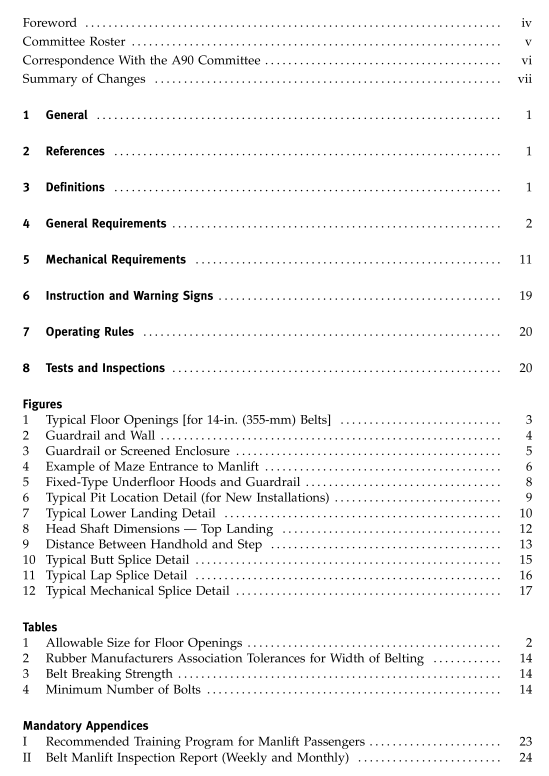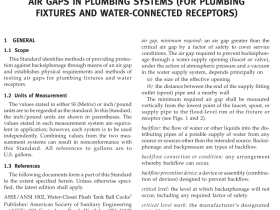ASME A90.1 pdf download

ASME A90.1 pdf download Safety Standard for Belt Manlifts
manlift: a power-driven endless belt that moves in onedirection only,and is provided with steps (platforms)and handholds for the transportation of personnel fromfloor to floor.
rated speed: the speed of the belt at which the manlift isdesigned to run (refer to para. 5.4).
safefy sfop device: any electrical or electromechanicaldevice (such as a limit switch, photoelectric eye, or prox-imity probe) that shall cause the electric power to beremoved from the driving machine motor and brakestopping the manlift.
seoere belt damage: the protective outer cover of a belt thatbecomes cut, cracked, or separated, exposing damagedinner fabric, and such damage that extends across thefull width of the belt or spans between adjacent boltholes.A torn belt is also considered severe.
split-rail safety sfop: an electric limit switch operatedmechanically by the rollers on the manlift steps.
step (platform): a passenger-carrying unit.
superficial belt cover damage: the protective outer coverof a belt that becomes scratched, cut, or cracked,exposing the inner fabric.Such damage is not continuousacross the full width of the belt.
torn: a severance of any length or width that goesthrough the entire thickness of the belt.
GENERAL REQUIREMENTS
4.1 Floor Openings
4.1.1 Allowable Size. New installations shall haveminimum floor openings of 30 in.(760 mm) and maxi-mum floor openings of 38 in.(965 mm). Floor openingwidths for both the up- and down-runs for existinginstallations shall be in accordance with Table 1 andFig.1.
4.1.2 Uniformity. All floor openings for a given manlift shall be uniform in size and shall be approxi- mately circular, and each shall be located vertically above the opening below it.
4.2 Riding Clearance (a) There shall be no encroachment ofany kind within the cylindrical space defined by the outer edges of the floor openings for the entire run of the manlift. (b) Should maintenance or construction work be planned for in close proximity to the manlift causing an encroachment on the space defined in para. 4.2(a), the manlift shall be shut down during such work.
4.3 Landings
4.3.1 Vertical Clearance. The clearance between the floor or mounting platform and the lower edge for the underfloor hood above it required by para. 4.4 shall be not less than 7 ft 6 in. (2 285 mm). Where this clearance cannot be obtained, no access to the manlift shall be provided, and the manlift runway shall be enclosed where it passes through such floor. The enclosure shall be equipped with an emergency exit.
4.3.2 Clear Landing Space. The landing space adja- cent to the floor openings shall be free from obstruction and kept clear at all times. The landing space shall be at least 2 ft (610 mm) in width from at least one edge (one, two, or three) of the floor opening used for mount- ing and dismounting (see Fig. 2, 3, or 4 for typical land- ing spaces).
4.3.3 Lighting of Landings. Adequate lighting, not less than 5 fc (54 lx), shall be provided at each floor landing at all times when the lift is in operation.
4.3.4 Landing Surface. The landing surface at the entrances and exits to the manlift shall be constructed and maintained to provide safe footing at all times.
4.3.5 Emergency Landings. Where there is a travel of 50 ft (15 m) or more between floor landings, one or more emergency landing(s) shall be provided so that there is a landing (either floor or emergency) for every 25 ft (7.5 m) or less of manlift travel.
(a) Emergency landings shall be accessible from both the up- and down-runs of the manlift and shall give access to the ladder as required in para.
4.8.
(b) Emergency landings shall be provided with stan- dard railings and toeboards.
(c) Platforms constructed to give access to bucket ele- vators or other equipment for the purpose of inspection, lubrication, and repair may also serve as emergency landings under this paragraph. All such platforms shall then be considered part of the emergency landing and provided with standard railings and toeboards.









